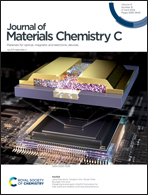Alloying strategy for developing a single-band warm white emitting material Cs2NaGdCl6:Bi3+via Ag+ co-doping†
Abstract
Efficient and versatile materials that are both non-toxic and environmentally sustainable have become paramount in our pursuit of greener and more durable illumination solutions. In this study, we investigated the optical properties of rare-earth-based all-inorganic perovskite (AIP) crystal Cs2NaGdCl6 (CNGC) with various substitutions to explore its potential applications in lighting devices. The primitive crystal CNGC exhibits intrinsic blue emission due to its self-trapped excitons (STEs) but singly-doping with Bi3+ ions results in weak blue emission, indicating quenching of the STE emission. Alloying by introducing Ag+ ions into the CNGC:Bi3+ lattice, replacing the Na+ ions, caused the disruption of the crystal field symmetry, which lifts the parity-forbidden selection rule and allows for s–p transitions of the Bi3+ ions. Thus, the co-doping with Ag+ ions in addition to Bi3+ leads to intense broad-band warm white emission covering a wide spectral range of 470–800 nm, with a correlated color temperature (CCT) of 4512 K and a color rendering index (CRI) of 79. The findings from this study provide valuable insights for the development of efficient and high-quality lighting devices using a simple technique.



 Please wait while we load your content...
Please wait while we load your content...